|
|
|||||||||||||||
|
|||||||||||||||
|
Privacy Policy | Editorial Policy | Profit Policy | Join the Association | List of Members | Contact us | Index | Links |
|||||||||||||||
|
Back Go to page: 1 2 3 4 5 6 7 8 9 10 11 12 13 14 15 16 17 18 19 20 Forward
|
|||||||||||||||
|
John Laming Aircraft and other stuff. |
|||||||||||||||
|
|
|||||||||||||||
|
With the elephant ears on top.
“You’re going to Williamtown to fly fighters,” said my instructor, waving posting authority PZ 440 at me. “Be there on the 1st February, best of luck and don’t kill yourself.” I am sure he thought I was better suited for Dakotas but was kind enough to keep that to himself. At the RAAF Advanced Flight Training School, Point Cook, Victoria it was now early December 1952 and the graduation parade for No. 8 Pilots Course was the next day.
A few weeks later, hoisting the heavy blue kit bag over my shoulder I stepped off the bus at the guard gate at RAAF Base Williamtown. The heady aroma of kerosene fumes pervaded the air as two Vampires bustled along a nearby taxiway. Of course I had seen photographs of jet aircraft but these could never capture the thrill of actually seeing one in the flesh, so to speak. The howling shriek of their turbines was intoxicating and I now knew how the children of Hamelin must have felt as they followed the Pied Piper merrily leading them away from their homes forever. Pilots' paradise was right here and I was getting paid for it!
|
|||||||||||||||
|
|
|||||||||||||||
|
The Orderly Sergeant showed me to my quarters, his only expression a disapproving glance at my carefully crumpled service cap (spring backing removed by judicious use of a razor) the top button of my battle jacket casually undone fighter pilot style and of course newly sown wings on my chest. He had seen it all before. Modern generation schoolboys affect a similar casual approach; sauntering in public with shirt tails flapping outside their trousers.
As I upended the kit bag contents on to my bed, the sound of Rolls Royce Merlins filled the air and I raced outside in time to see a formation of four Mustangs peeling off at 200 ft into buzz and break landings. We had practiced these landings at Point Cook when flying Wirraways but on Mustangs they looked real cool (as my daughter would say).
Although I flew these Mustangs over the next few weeks, the lead up
training to graduation as a fighter pilot was on the single seat
Vampire, the subject of this story. In between lectures on tactics,
reading reports on escape and evasion, rifle drill and Orderly Sergeant
duties and daily flying schedules there was precious little time before
first solo to read RAAF Publication No. 839 Pilot’s Notes (PN) for
Vampire Mk.30. Apart from Mustangs the only aircraft I had flown were
Tiger Moths and Wirraways. There was no engineering course and except
from one schematic diagram of the fuel
43. Diving and High Speed Flying.
Individual aircraft are known to have different compressibility characteristics…warning of the approach of compressibility may be given by one or a combination of the following characteristics…a progressive backward movement of the control column for a constant angle of dive…sharp snatching of either wing from about 0.76 Mach onwards…as the limiting speed is approached, a progressive nose down change of trim may occur and heavy stick elevator forces are required to prevent the dive becoming steeper…below 10,000 ft at M0.76 stick forces may fluctuate and there is strong longitudinal buffeting accompanied by nose down change of trim which may be pronounced….the aircraft may break away in a series of sudden pitching oscillations in either upward or downward direction.
Below 20,000 ft at the high IAS range, limiting Mach number is determined by a different vice, namely a severe nose down trim change which builds up very rapidly above Mach 0.75 at 15,000ft.
A few months earlier I had ticked the box marked Fighters in response to posting preference after graduation as a pilot. In hindsight it may have been wiser to opt for transports or bombers if I had seen the following report on diving trials on the Vampire Mk 30. These trials took place after several fatal accidents involving the Australian built Vampires during operational training. The test pilot, Group Captain Brian “Black Jack” Walker, described the vagaries of the Rolls Royce Nene powered Vampire. His comments are edited for space and clarity:
“It is worth considering the difference between the English Vampire with its single-sided impeller and the Australian one with its double-sided impeller. The designers of the Australian had decided that as well as the considerable intakes on each side of the fuselage which fed the engine with air, it would need some auxiliary intakes on the top of the fuselage behind the canopy to feed the backside of the impeller with the extra air needed. They called them Elephant’s Ears. In 1951, two Vampires engaged in fighter tactics went into the ground in an almost vertical dive. Apparently they never looked like recovering. A few months later a third Vampire crashed during a similar manoeuvre. None were fitted with ejection seats.
So De Havilland, to whom the matter had referred, told me. “You, Mr Test Pilot., had better take the next Vampire up and see what happened to those aeroplanes.” Well do I remember that flight. I took it up to well over 40,000 ft and put it into a very steep dive, as steep as I dared, with not too much power because if anything was going to happen I wanted it to happen fairly quickly. I soon found out. Once the aeroplane went over Mach 0.8, the nose got heavier and heavier and the aeroplane kept on endeavouring to go past the vertical and the controls were largely ineffective. I closed the throttle and extended the dive brakes immediately and this was around 27,000 ft. The aeroplane obviously had to be got out of a very sticky situation. I was even thinking of throwing the undercarriage out, which would have probably destroyed the fairings, but – anything to slow it up.
|
|||||||||||||||
|
|
|||||||||||||||
|
Vampire Mk 30 with elephant ears on top of the engine. |
|||||||||||||||
|
Fortunately, as I descended to 20,000 ft I could feel the controls slowly becoming more effective and I was able to lift the nose up from almost vertical to an attitude where the Mach number was slowly decaying and recovery was becoming possible. We eventually came out of that dive at about 13,000 ft. As the characteristics were so different to the English Vampire at high Mach numbers, it seemed to me it must have something to do with those wretched Elephant’s ears on the upper surface of the fuselage.
The design team did a quick switch around and took the auxiliary intakes from off the top of the fuselage and placed them on the bottom of the fuselage. This time I started well over 40,000 ft and put into a 70 degree dive. I was ready for it this time. Imagine my relief when, instead of ducking it’s nose down, once I reached Mach 0.80 the nose began to rise. This was 1951 and Mach 0.84 was high. We had much to learn but that solved that problem with the Vampire and thereafter they all had their auxiliary intakes underneath the cowl, in spite of the fact that on a grass aerodrome the intakes could suck in tufts and dust.”
Nevertheless, after the Mustang course I was allotted for my first flight – A79-915, a single-seat Vampire with elephant ear intakes on top of its fuselage - not underneath. Modified Vampires, Mk 31’s with ejection seats, had not yet arrived in squadron service. While stories of the Vampire tuck-under phenomenon caused a few raised eyebrows, these concerns were brushed aside in the excitement of one’s first flight in a solo Vampire – the dual version having not yet arrived at the OTU In any case, having safely got away with flying the Mustang the thought of first solo in a Vampire did not faze me.
|
|||||||||||||||
|
|
|||||||||||||||
|
Our base being near the sea, it was with more than passing interest I read in the Emergencies section of the Pilot’s Notes that: “Where possible, the aircraft should be abandoned by parachute rather than ditched since experience indicates that, in any but the calmest sea, the ditching qualities will be very poor.” A charming thought, for sure…
If ditching was not good for the pilot’s health, abandoning the aircraft by parachute had its own hazards. Remember there was no ejection seat. Read on:
“Reduce speed to minimum at which the aircraft can comfortably rolled on its back. Jettison the canopy. Trim as nose heavy as possible while still being able to maintain control by over-riding the trim with the control column. Disconnect radio lead and oxygen. Roll the aircraft on its back. Release safety harness at same time allowing the aircraft to go forward. The resultant bunt should throw the pilot clear of the tail-plane. Pilots are advised that where possible a forced landing should be chosen in preference to abandonment by parachute.”
With full internal fuel tanks, the safe endurance for general flying, including aerobatics, was only 45 minutes, reminding me of the story of a United States Air Force pilot who flew the Boeing B52 Superfortress. Used to flying ten hour sorties, he was offered a trip in a Vampire during a stop-over in England. On hearing the safe endurance of the aircraft was just under an hour, he was none too happy, remarking that he was in a Mayday situation even before engine start!
Despite the negatives, it was nice to know the following minimum speeds in IAS were recommended for aerobatics.
|
|||||||||||||||
|
|||||||||||||||
|
|
|||||||||||||||
|
|
|||||||||||||||
|
|
|||||||||||||||
|
Deliberate spinning of the Vampire was prohibited; the good news being if an inadvertent spin was encountered, standard recovery action was effective. Because some engines were not fitted with a strengthened turbine disc hub-shaft, prolonged spinning could lead to subsequent failure of the shaft and subsequent engine failure. That left the pilot with Clayton’s Choice of ditching, parachuting, or forced landing.
One natty point remained. The Emergencies section of the PN advised the pilot that:
“Should fire become apparent in the engine nacelle the high pressure fuel cock lever should be at once set to Fuel Off, the throttle should be closed fully and speed should be reduced as far as practicable by opening the dive brakes and pulling up the nose of the aircraft before the extinguisher is operated.”
A fire in the engine would cause a red light to come on in the cockpit. For some reason the aircraft designer decided that once actuated, the fire warning light should stay on, whether the fire was out or not. It was Catch 22 for the pilot. If fire is evident he must bale out quickly with all the implied risks. If the fire goes out, he was still in trouble because the engine has stopped leaving him to again toss a coin whether to bale out, ditch, or belly land. It remained for the pilot to conduct a hasty turn and look behind for a smoke trail. Of course, Sod’s Law ensures the aircraft is in IMC when a fire warning occurs. The pilot stop-cocks the engine, pulls up to slow up, hits the engine fire extinguisher button and soon after whips into a no engine steep turn to look for a smoke trail. Meanwhile the artificial horizon topples in the steep turn and the pilot is left to recover on limited panel. Now that is earning your pay.
For my first trip an instructor leaned over the cockpit and talked me through the starting procedure. The control column spade grip had a veritable forest of switches including the brakes lever, gun firing push-button, cine camera control and bomb and rocket projectile release controls. The VHF radio transmit button was in the throttle. Looking at each switch I was fleetingly reminded of a story about a senior RAAF officer who had recently flown for the first time a modified Mk 31 Vampire. This aircraft had transposed VHF radio and rocket firing switches - the reverse of the Mk 30 with which he was more familiar. The VHF transmit switch was now on the control column while the rocket firing switch was in the throttle. After arming the rockets he pressed the radio transmitter button to announce his arrival over the bombing range. To his astonishment one of his rockets fired off. With commendable alacrity the Group Captain called range control warning of a rogue rocket firing. A second missile ignited and launched from its rail. Stunned, the pilot tried to again warn range control, firing off a third missile before twigging that the position of the Vampire’s radio and rocket switches must had been reversed.
Once the engine of my aircraft was idling the instructor left me to it. From now on I was on my own. With other Vampires starting at the same time, the air was thick with fumes of burnt kerosene. I followed a Mustang taxiing to the same runway, the pilot weaving the nose from side to side to ensure the way was clear. Taxiing the Vampire was relatively easy with gentle use of pneumatic brakes to initiate turns, remembering to apply rudder in the direction of the turn before squeezing the brake lever. The lack of nose wheel steering invariably meant Vampires taxiing were characterised by nodding nose wheel struts as pilots tried to find the happy medium of brake and rudder. Each squeeze of the brake lever bled air pressure from an accumulator topped up to 450 PSI before engine start and when taxiing long distances it was important to keep a close eye on brake pressures.
The RAAF Central Flying School (CFS) based at East Sale in Victoria, was responsible for Service flight standards.
|
|||||||||||||||
|
|
|||||||||||||||
|
|
|||||||||||||||
|
CFS taught a standard pre-take off drill, modified where necessary for different types of aircraft. It was a familiar mantra starting with harness, hatches, hydraulics, trims set for take off, flaps set, fuel checked and so on. Specific checks for the Vampire included checking the dive brake lever was selected to off and canopy seal switch on. Being my first trip in a tricycle undercarriage aircraft I marvelled at the unrestricted vision from the cockpit, especially when compared to the blind spot caused by the long nose of the Mustang.
Once cleared for take off, the throttle is slowly advanced to the stop, giving 12,300 rpm. The aircraft is very low to the ground and high power on the brakes causes the hot gases from the jet pipe to melt the tarmac. For this reason it is preferable to conduct a rolling start for take off. The acceleration was sensational and except for a muffled whine from the turbine there was almost no sound in the cockpit. Used to the shattering noise of a Rolls Royce Merlin at 3000rpm and the high cockpit position of the Mustang, it was almost unnerving to watch in silence as the runway becomes a blur of speed just inches below the cockpit. It reminded me of a bob sleigh driver skimming at high speed down a slope. Initial dabs of rudder and a quick squeeze of the brake lever kept the Vampire straight until the twin rudders became effective around 60 knots.
Page 30 of RAAF Vampire PN explains the take off technique, thus:
“Keep straight initially with gentle use of brakes, then as speed is gained, by use of rudders. Ease the nose wheel off the ground at about 70-75 knots, taking care not to get the nose wheel too high or the tail may touch the ground. The aircraft, which does not un-stick cleanly, should be flown off at about 105 knots. When comfortably airborne brake the wheels and retract the undercarriage. When drop tanks are carried it is essential to raise the undercarriage before 125 knots is attained; otherwise the wheels may not lock up. Do not start climbing until a speed of approximately 115-125 knots is reached and endeavour to reach the recommended climb speed as soon as possible.”
Many years later I flew the Boeing 737; its published take off procedure being quite different to the Vampire. This included no lifting of the nose wheel until a specified speed for rotation about the main wheels was reached. This speed varied with flap setting and weight and guaranteed a safe lift off. The Vampire does not lift off cleanly, having to be coaxed rather than be lifted off. Lacking experience in those days, I accepted advice from experienced Vampire pilots that 75 knots was nose wheel lift off and the aircraft flown off the ground around 105 knots. Even so, I was never entirely comfortable with that technique.
While the view over the nose was good the absence of external cues on which to judge nose attitude (body angle is now the term) made it easy to misjudge the optimum attitude. When the time had come to lift the nose wheel during the take off run there was no reliable method of judging just how high the nose wheel was off the ground or indeed if it was still on the ground. I found the aircraft would break ground at somewhere between 100-110 knots although I think I felt the aircraft into the air rather than concentrate on the airspeed indicator. Lift off was a distinctly uncomfortable - rather like being in a no-man’s land of semi-airborne but not safely. Other British designed types using the early nose wheel lift off technique included the Comet airliner and Canberra bomber.
There is little doubt in my mind now that the real danger was the inadvertent high angle of attack if the nose wheel was lifted too high. With induced drag increasing as the aircraft accelerates there comes a time where the aircraft may not reach un-stick speed by the end of the runway. Two Comet accidents attributed to pilot error may have been caused by over-rotation early in the take off run. In one case there was evidence of the tail dragging along the runway. Both aircraft failed to reach lift off speed. The short nose of the Comet and the Vampire made it difficult, especially at night, for the pilot to judge the optimum nose attitude when lifting the nose wheel. This was later illustrated during the investigation by New Zealand air safety authorities into the crash of a civilian owned Vampire F9. There was evidence the pilot lifted the nose too high during the take off run causing the aircraft to stop accelerating. He abandoned the take off too late to stop the aircraft from over-running the strip.
Knuckling my forehead in order to recall more details of that first Vampire trip, I came across this report from the Flight Safety Foundation on the first Comet airliner accident as it relates to the lifting of the nose wheel during the early part of the take off run:
|
|||||||||||||||
|
|
|||||||||||||||
|
|
|||||||||||||||
|
|
|||||||||||||||
|
The Comet aircraft, named "Empress of Hawaii" and on a delivery flight to Canadian Pacific, did not become airborne on takeoff and crashed into the dry bed of a river. CF-CUN was the first passenger jetliner involved in a fatal accident.
PROBABLE CAUSE: "The accident was caused by the fact that the nose of the aircraft was lifted too high during the takeoff run, resulting in a partially stalled condition and excessive drag. This did not permit normal acceleration and prevented the aircraft from becoming airborne within the prescribed distance. The pilot appears to have realised that the nose was excessively high and took corrective action, but this was done too late to prevent the aircraft striking an obstruction immediately beyond the perimeter fence before it became airborne.
CONTRIBUTORY CAUSE: The pilot, who had only limited experience in the Comet aircraft, elected to takeoff at night at the maximum permissible takeoff for the prevailing conditions. The circumstances required strict adherence to the prescribed takeoff technique, which was not complied with."
In his fine book “Handling the Big Jets” test pilot D.B. Davies, wrote of a Comet accident:
“The very first type of flying accident specifically related to civil jet transport aircraft was the take-off accident in which, due to an error in rotation, the aeroplane failed to leave the ground in the distance available. The reason for this is now well understood and almost ancient history, and a lot of work has been done, and requirements written, to guard against it in the future. But the basic danger still exists, though in a slightly less critical fashion, and the importance of a correct rotation technique cannot be overrated.”
The early jet transport had a rather symmetrical wing section designed primarily for good high speed qualities. This section was a critical producer of lift…because the rather sharp nose profile caused the wing to stall at an incidence which could be reached on the ground if the aeroplane were rotated to too high an angle. This critical incidence occurred before tail grounding limited the maximum achievable incidence.
|
|||||||||||||||
|
|
|||||||||||||||
|
De Havilland Comet. Note short nose making judgement of attitude difficult due to lack of visual cues.
|
|||||||||||||||
|
Those pilots having the good fortune to fly the War-Bird version of the Vampire, single seat or dual, would perhaps be wise to study the advice offered by D.B. Davies especially as the original Pilots Notes for the Vampire advocate the early lifting of the nose wheel on take off.
Despite advancing years I have no difficulty in remembering one spectacular incident that occurred during the fighter course. From the control tower I watched a squadron of Vampires take off in pairs’ formation. As the last aircraft in the formation became airborne the pilot encountered jet wash from the others ahead. Undercarriage still retracting, his Vampire hit the runway, skidding sideways in a huge pall of dirt and dust. I saw a brief flash of red from the area of the cockpit as the aircraft finally fish-tailed to a halt on the grass verge.
Initially I thought the Vampire was on fire but later realised the red flash was nothing more than the pilot’s fluorescent survival scarf streaming behind as he jumped from the cockpit to safer pastures. With the engine still operating at high power because of damage to the fuel shut-off system, the pilot could do nothing except watch from afar as fire crews squirted water into the air intakes to flame out the engine. This accident convinced me of the folly of allowing the aircraft to unstick when it was ready instead of first reaching a safe rotation speed.
Now back to the story of my trip where I managed to get airborne safely. After the undercarriage lever was selected up, and the red lights were out, I held the aircraft down low, accelerating to the recommended climb speed. Now this was fun and the thrill of a lifetime to flash over roads and people at 200 feet in level flight accelerating just like the book said to 290 knots. A bird strike in the cockpit at that speed would have been fatal especially as sea gulls abounded near the coast. But at the tender age of twenty-one, 260 hours in my logbook and a bulletproof windscreen, I was immortal. In any case I had no idea in those days that the force of the impact with a bird was equal to half of the mass of the bird multiplied by the square of the true air speed of the aircraft. I bet none of the squadron pilots and fighter combat instructors knew that, too. Google had not been invented then…
It was almost with regret I reached 290 knots where my low flying was converted into a climb. And what a rate of climb it was. The IVSI needle was hard against the 6000ft stop on the instrument face and the Vampire was rocketing up. No wonder the initial rate of climb was so high, however. With lack of nose attitude reference that was obvious in the Mustang, I had pulled the nose too high after reaching 290 knots and lost 50 knots in the zoom. Soon the rate of climb fell off to 2000 fpm and I was forced to again fly level to accelerate back to 290 knots. Precision flying it was not.
I don’t recall the specifics of the pre-flight briefing for the first
flight in a Vampire except it was normal practice to conduct a few steep
turns, some aerobatics, maybe a clean and dirty stall and of course keep
a close eye on the extent of the training area and the cloud base. With
other aircraft in the same area one had to keep one’s eyes
The early single seat Vampires had no radio aids to navigation; the
pilot relying on a single VHF set (the 1936) for homing to the aerodrome
and instrument let down. If the VHF went on the blink you were in
trouble. We were briefed to then fly a triangular pattern and hopefully
ATC would see this on radar and be alerted to your problem. Time
permitting, an aircraft would be scrambled to find you if you were above
cloud and then lead you down while you kept close formation. Those who
have read “The Shepherd” by Frederick Forsyth will recall the story of a
Vampire
Thus on my fighter course we requested a “QGH” let down, followed, if the weather was really bad, by a GCA to 200 ft. QGH was Q code for “I wish to land.” (You can see the full Q codes HERE) ATC would pick up your radio transmissions on his VHF Direction Finder (VHF/DF). GCA meant Ground Controlled Approach. The pilot would home overhead the aerodrome at 15-20,000 ft using headings given by ATC. Descending at 4-6000 ft per minute the aircraft would be turned inbound after a specific time interval or altitude, meanwhile slowing to final approach speed. ATC would instruct the pilot to change to GCA radio frequency from where another operator talked the pilot to touch-down. It was quite reassuring to break out of cloud at 200 ft and a few seconds later hear the GCA controller saying in a calm voice “over the runway, touch down, touch down NOW.”
Fortunately the weather was fine for my first solo and mindful of the high fuel consumption and limited endurance I made sure I was back in the circuit before 45 minutes was up. During pre-flight briefing we had been told to ensure the Nene engine was spooled up once full flap was selected. My approach was dreadful - far too long and skimming the trees. Crossing the fence at 115 knots (much too fast) the aircraft seemed to float for ages before touching down. I used the full length of the runway to stop, following the technique described in the Pilot’s Notes:
“Make a normal tricycle landing holding the nose wheel off the ground as long as possible to shorten the landing run. Do not apply the brakes until the nose wheel has settled firmly on the ground, and then apply them gently and progressively in short applications.”
Again, one had to be careful not to scrape the tail on the first part of the landing roll because it was all too easy to hold full back stick to give barn door drag effect at the high angle of incidence. In modern airliners, the technique is different. On touch down, the aircraft is allowed to de-rotate with the nose wheel being flown on to the ground. The aim is to deploy wing lift spoilers on touch down so that as soon as all wheels are on the ground the brakes can be used to stop the aircraft. And of course, remembering if reverse thrust is available this is most effective at high speeds.
|
|||||||||||||||
|
|
|||||||||||||||
|
|
|||||||||||||||
|
I recall that in the fifties, the RAF published a flight safety journal called “Air Clues” – the editor using the pseudonym – “Wing Commander Spry.” He commented on a Vampire overrun accident, where, after the brakes had failed, the pilot attempted to slow up by winding open his canopy in the hope of obtaining more drag. With brilliant wit the Wing Commander suggested greater drag could be created by the simple expedient of tying a handkerchief at the corners and hanging it out of the cockpit in the form of a braking parachute… I loved that one – great British sense of the ridiculous.
First Vampire solo over, it was now time to get to more serious flying – and that included Mach runs. The second flight included a pairs’ formation take off. The lead aircraft was flown by an experienced fighter combat instructor who had recently returned from flying Meteors on operations against the invading Chinese in Korea. We climbed to 30,000 ft where I was given the lead and instructed by radio to ease into a dive. We had previously been briefed on the effects of compressibility but there was a world of difference between the theory and getting one’s hands dirty, so to speak.
The idea was that the instructor in his Vampire would, from previous experience as he followed my dive, pick the effect of compressibility well before I could be expected to. As soon as his aircraft began to tuck under, he warned me to close the throttle, extend the dive brakes and recover from the dive. I must admit to not experiencing anything unusual in the dive before I followed the instructor’s orders to slow up. The exercise was a non-event as far as I was concerned – and of course precisely why an instructor was there to ensure it was a non-event. The previous fatal accidents revealed slow recognition of initial compressibility effects was a contributory cause to those accidents. (Click HERE to see a video on the effect, it will take a few seconds to load.)
During flight, a wing produces lift by accelerating the airflow over the upper surface. This accelerated air can, and does, reach supersonic speeds, even though the airplane itself may be flying at a subsonic airspeed (Mach number < 1.0). At some extreme angles of attack, in some airplanes, the speed of the air over the top surface of the wing may be double the airplane’s airspeed. It is therefore entirely possible to have both supersonic and subsonic airflow on an airplane at the same time. When flow velocities reach sonic speeds at some location on an airplane (such as the area of maximum camber on the wing), further acceleration will result in the onset of compressibility effects such as shock wave formation, drag increase, buffeting, stability, and control difficulties. Subsonic flow principles are invalid at all speeds above this point.
Over the next three weeks I flew the single seat Vampire on more than thirty occasions – most being of 45 minutes duration. Many of these flights were in formations of two or four aircraft and included cloud flying, battle formation and tactics, low level map reading, cross-country flying with drop tanks, cine-camera quarter attacks on the “stooge” – (another Vampire acting as the target), instrument flying and GCA landings. Perhaps the outstanding memory was a low level navigation exercise at 300 knots including one leg over water. Briefed to fly at 200 ft, believe me there was little time for heads down map reading. We could go as low as 50 feet above the ground as long as we didn’t upset people. Part of the briefing included watching a Royal Air Force training film on low level navigation. The aircraft in the film was a DH Mosquito war-time fighter bomber with a camera in the cockpit recording the view from the pilot’s seat. The aircraft was right on the deck, navigation being by timing. Railway and road junctions, church steeples and power lines flashed past, the Mosquito flying at 280 knots. It was an enthralling film and I longed to fly that low legally – which of course I did in the Vampire the next day. The best part was easing down to fifty feet above the ocean in the Vampire and building up speed to 350 knots. The thought of hitting a flock of sea gulls at that speed never occurred to me and with hindsight 53 years later, I shudder to think of the consequences. But we are only young once.
Self and a Dual Vampire Mk 35
After a period of general handling, we landed and taxied to the tarmac. The squadron leader opened the canopy and actuated the locking mechanism. Having by now disconnected radio leads, ejection seat straps, and oxygen hose, I hauled myself from the seat by grasping the front windscreen frame. I was half-way out when the kindly squadron leader told me to sit back down and listen to his words of wisdom. They were that I should always make sure the clam shell canopy was indeed truly locked in the vertical position lest a gust of wind blew it down upon the pilot’s hands as he exited from the cockpit.
Grateful for this sage advice, I watched as the squadron leader having by now divested himself of radio and other sundry leads, hauled himself up by gloved hands on the bow of the windscreen. Of course, Sod’s Law ensured the canopy had not only not locked properly, but a divine wind also blew it shut, squarely trapping my instructor’s hands between windscreen and canopy bow. With a frightful oath of “Schiesenhaussen” (translate that as you will, but I didn’t know German at the time) the normally unflappable Squadron Leader wrung both hands in pain. In fact he had suffered two broken fingers.
I nearly wet myself with laughter and with ill-timed humour congratulated him on a realistic demonstration of the dangers of unlocked canopies. He was not amused and his reply through clenched teeth of “That’s not bloody funny, flight sergeant” was clipped and concise - as it would be, of course.
And now in 2006 a single seat Vampire with elephant ears underneath the fuselage can be seen at the RAAF Museum at Point Cook – the base from where I graduated as a pilot more than 50 years ago. Occasionally one old codger turns up there accompanied by some young airline pilots who he once trained. And he has been known to tell them the story of his first trip in a Vampire…the one with the elephant ears on top, of course.
|
|||||||||||||||
|
|
|||||||||||||||
|
|
|||||||||||||||
|
|
|||||||||||||||
|
|
|||||||||||||||
|
|
|||||||||||||||
|
|

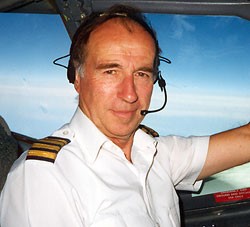

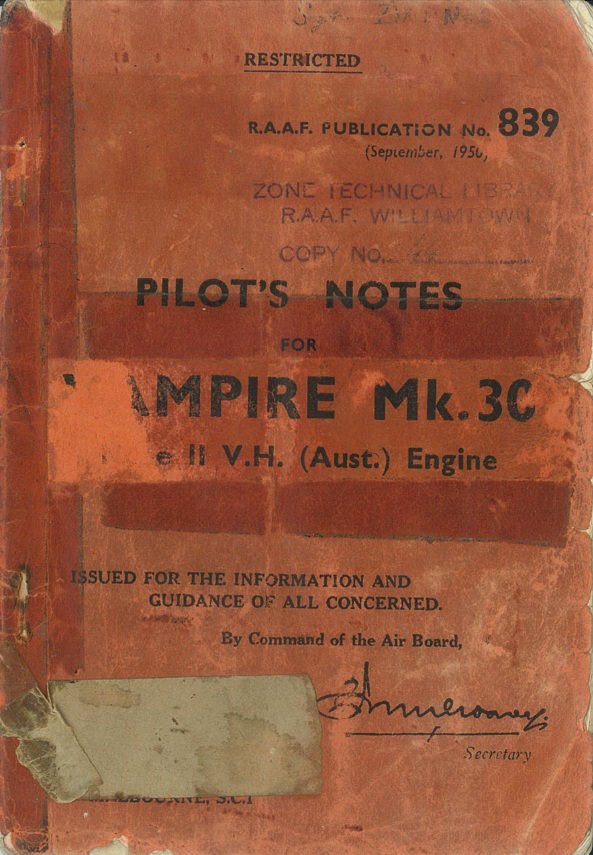 system the only other pictures in the PN were of the cockpit. Page 29 of
PN Vampire certainly had my undivided attention when I read:
system the only other pictures in the PN were of the cockpit. Page 29 of
PN Vampire certainly had my undivided attention when I read: 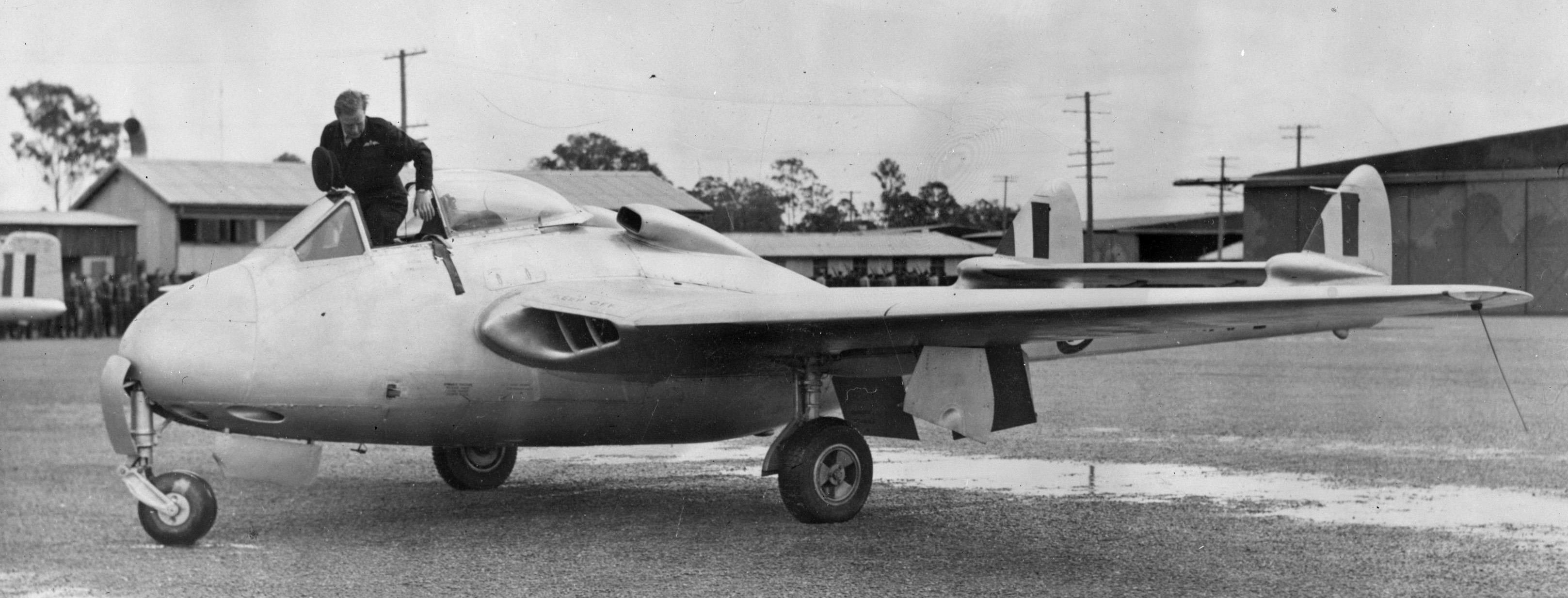

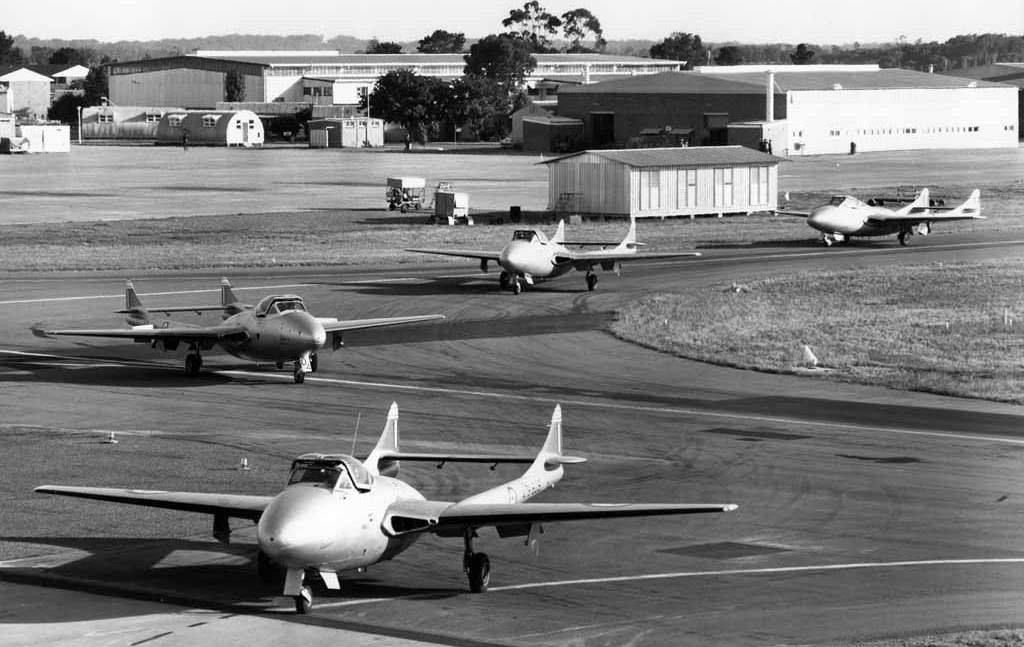
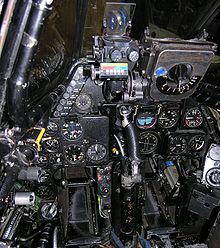
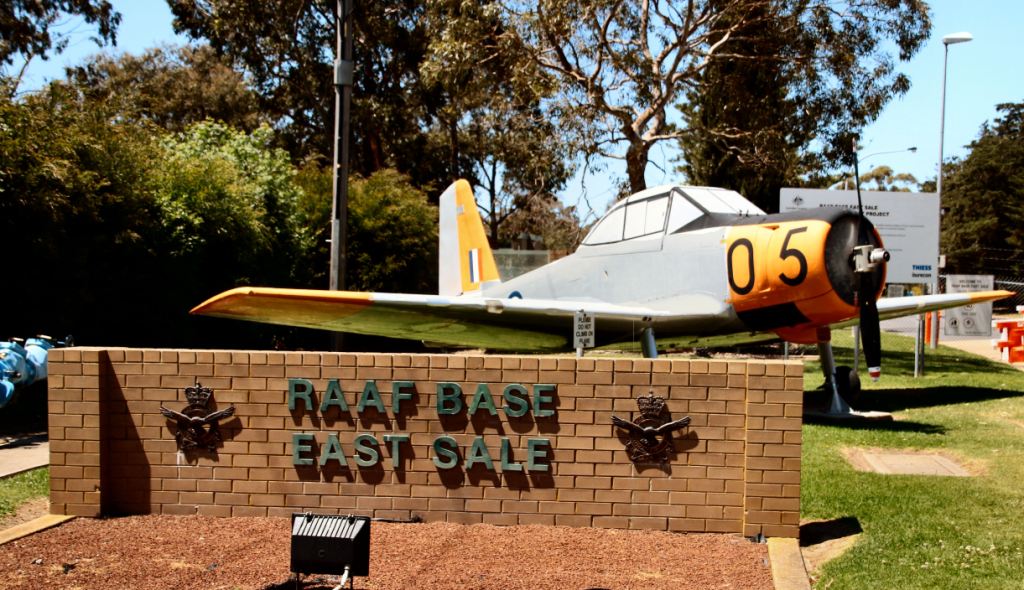
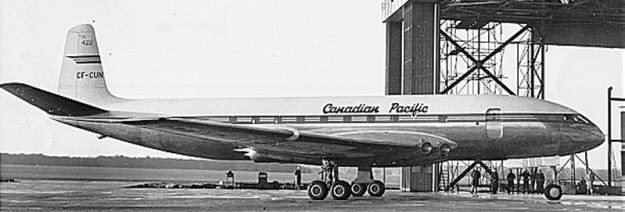

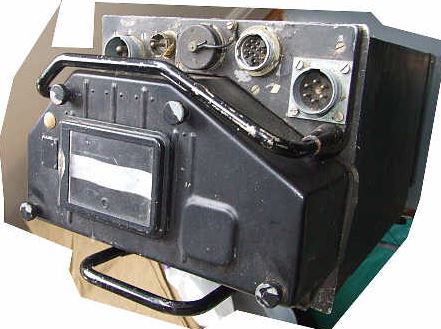 skinned, particularly as we were encouraged to “bounce” any fighter seen
in the area and of course get bounced in return. Lazy barrel rolls were
a dream in the Vampire and at 350 knots entry speed, a roll of the top
of a loop covered thousands of feet vertically. A normal loop I
approached with caution; remembering one fatal accident where the
unfortunate pilot found himself in compressibility when he was too slow
to close the throttle and extend the dive brakes in the dive recovery.
skinned, particularly as we were encouraged to “bounce” any fighter seen
in the area and of course get bounced in return. Lazy barrel rolls were
a dream in the Vampire and at 350 knots entry speed, a roll of the top
of a loop covered thousands of feet vertically. A normal loop I
approached with caution; remembering one fatal accident where the
unfortunate pilot found himself in compressibility when he was too slow
to close the throttle and extend the dive brakes in the dive recovery.
 pilot,
having lost all communication while flying over the North Sea, is found
by a ghostly Mosquito. Using hand signals the Mosquito pilot had the
Vampire pilot take up close formation and eventually led him down
through thick fog to land safely on an old wartime runway. During the
landing roll the Vampire engine flamed out due to lack of fuel. That
story is one of my favourites.
pilot,
having lost all communication while flying over the North Sea, is found
by a ghostly Mosquito. Using hand signals the Mosquito pilot had the
Vampire pilot take up close formation and eventually led him down
through thick fog to land safely on an old wartime runway. During the
landing roll the Vampire engine flamed out due to lack of fuel. That
story is one of my favourites. 
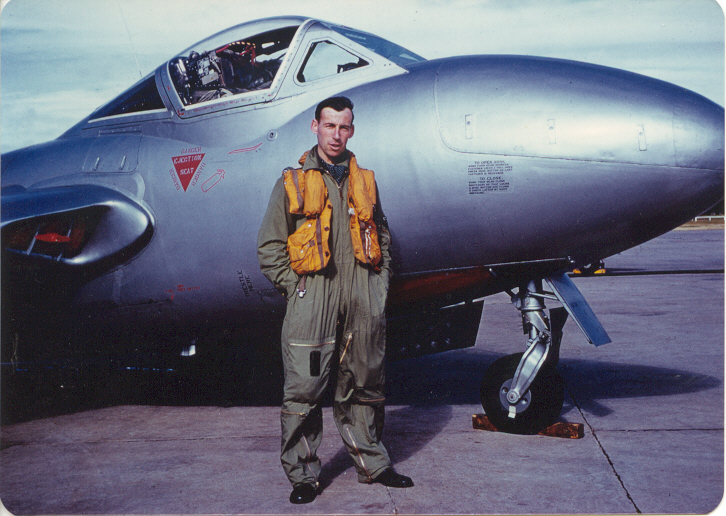 In
later years I flew the dual Vampire Mk 35. It had a clam-shell type
canopy and Martin Baker ejection seat. Compressibility was no big deal,
as at onset the aircraft pitched up sharply instead of tucking under
into a dive. It was during a dual flight in the Mk 35 that I saw the
funniest thing ever. My instructor was a pukka squadron leader with a
small bristling moustache. He was formal but friendly with a manner of
speech that was clipped and precise.
In
later years I flew the dual Vampire Mk 35. It had a clam-shell type
canopy and Martin Baker ejection seat. Compressibility was no big deal,
as at onset the aircraft pitched up sharply instead of tucking under
into a dive. It was during a dual flight in the Mk 35 that I saw the
funniest thing ever. My instructor was a pukka squadron leader with a
small bristling moustache. He was formal but friendly with a manner of
speech that was clipped and precise. 